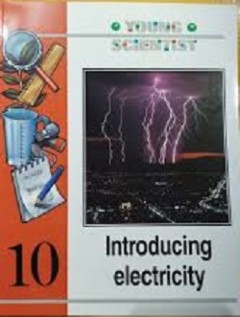Filter by

Magnetic Power
We use magnetism in so many ways that modern life would be imposible without it. We need magnetism to produce large amounts of electricity in power stations. There are magnets in compasses, loudspeakers, electric motors, refrigerator doors, cassette recorders, computer discs and many other useful appliances.
- Edition
- Cet.2, 1991
- ISBN/ISSN
- 716660598
- Collation
- p. 62: 28 cm
- Series Title
- Young Scientist
- Call Number
- 538 ALE m

Animals With Backbones
Did you know that all animals can be grouped as either vertebrates or invertebrates/ But what is a vertebrate? A vertebrate is an animal that has a spine, or backbone - a long column of bones running along its back. The animals in this large group can be divided into five smaller groups, or classes - fish, amphibians, reptiles, birds and mammals
- Edition
- Cet.2, 1991
- ISBN/ISSN
- 716660598
- Collation
- p. 62: 28 cm
- Series Title
- Young Scientist
- Call Number
- 596 BRA a

Animals Without Backbones
All these are invertebrates. An invertebrate is an animal that doesn't have a backbone. Of all the millions of animals in the world, only about 45.000 different kinds, or species, have backbones. By far the greatest group are the invertebrates. Scientists have already given names to more than one million different species.rnInvertebrate animals include sponges, corals and jellyfish: worms, star…
- Edition
- Cet.2, 1991
- ISBN/ISSN
- 716660598
- Collation
- p. 62: 28 cm
- Series Title
- Young Scientist
- Call Number
- 592 BAR a

Using Energy
What does energy come from? All energy comes from the Sun. The Sun's energy changes into other kinds of energy when it reaches the Earth. The Sun's energy is even in coal and oil. Long ago, the Sun gave its energy to plants and animals. When they died, their bodies slowly turned into oil and coal over millions of years. Power stations then change the energy in coal and oil into electrical energ…
- Edition
- Cet.2, 1991
- ISBN/ISSN
- 716660598
- Collation
- p. 62: 28 cm
- Series Title
- Young Scientist
- Call Number
- 621 BRA u

Discovering Gases
These are millions of different things in the world, but there are just three different forms of matter. These are solids, liquids and gases. Everything in the world belongs to one of these three main forms.rnYou can probably think of hundreds of different solids and liquids. Solids like sotne and wood are hard and stay the same shape. Liquids like water and petrol can flow from place to place.…
- Edition
- Cet.2, 1991
- ISBN/ISSN
- 716660598
- Collation
- p. 62: 28 cm
- Series Title
- Young Scientist
- Call Number
- 665 AIT d

Introducing Electricity
The contents are Electricity all around; inside the battery; what is static electricity; electricity in your home; wlong the wire; wiring in the home; measuring in volts; heatingup; switching on and off; making electricity safe; generating electricity; distributing electricity; living without electricity
- Edition
- Cet.2, 1991
- ISBN/ISSN
- 716660598
- Collation
- p. 62: 28 cm
- Series Title
- Young Scientist
- Call Number
- 537 BRA i

Investigating Light
This book explain about colour and white light; coloured objects; infra-red rays; glowing int the dark; atoms and light; refraction; images of light; looking through telecopes; the speed of light; making shadows; the human eye;........
- Edition
- Cet.2, 1991
- ISBN/ISSN
- 716660598
- Collation
- p. 62: 28 cm
- Series Title
- Young Scientist
- Call Number
- 621.323 BAR i

Key Book
Science is all about solving problems. But first, you must decide exactly what the problems is. Your set of Young Scientist will help you to find this out. Soon you will begin questioning everything around you. That is what real scientist do. They need to know why and how things happen. And they're never happy until they find out.
- Edition
- Cet.2, 1991
- ISBN/ISSN
- 716660598
- Collation
- p. 126: 28 cm
- Series Title
- Young Scientist
- Call Number
- 002 BRA k

Space Technology
This book talk about the solar system, light telescopes, rockets, orbits, space shuttle, satellite servants, communications and tracking, training the astronauts, going to the moon, space probes, voyage of discovery.
- Edition
- Cet.2, 1991
- ISBN/ISSN
- 716660598
- Collation
- p. 62: 28 cm
- Series Title
- Young Scientist
- Call Number
- 600 ALL s

The Planet Earth
- Edition
- Cet.2, 1991
- ISBN/ISSN
- 716660598
- Collation
- p. 62: 28 cm
- Series Title
- Young Scientist
- Call Number
- 523 GOW p
- Edition
- Cet.2, 1991
- ISBN/ISSN
- 716660598
- Collation
- p. 62: 28 cm
- Series Title
- Young Scientist
- Call Number
- 523 GOW p
 Computer Science, Information & General Works
Computer Science, Information & General Works  Philosophy & Psychology
Philosophy & Psychology  Religion
Religion  Social Sciences
Social Sciences  Language
Language  Pure Science
Pure Science  Applied Sciences
Applied Sciences  Art & Recreation
Art & Recreation  Literature
Literature  History & Geography
History & Geography